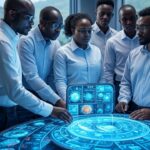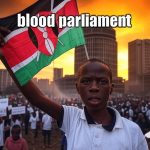The reported tensions between Orange Democratic Movement (ODM) leader Raila Odinga and Siaya Governor James Orengo over the formation of a broad-based government with President William Ruto’s United Democratic Alliance (UDA) reflect deeper ideological and strategic divisions within ODM. These divisions could significantly influence the Kenyan political landscape leading up to the 2027 General Election. Below is an analysis of the situation and a prediction of possible outcomes for the 2027 elections, based on available information and political dynamics.
Context of the Fallout
- Broad-Based Government: Raila Odinga’s decision to enter a political pact with President Ruto, formalized through a Memorandum of Understanding (MoU) on March 7, 2025, has led to the inclusion of ODM leaders in Ruto’s cabinet, including Hassan Joho, Wycliffe Oparanya, John Mbadi, and Opiyo Wandayi. This move, aimed at stabilizing the country after anti-government protests, has been framed by Raila as a pragmatic step for national unity rather than a full coalition. However, it has caused friction within ODM, with critics like Orengo arguing it compromises the party’s opposition identity and principles.
- Orengo’s Position: James Orengo, a long-time ally of Raila and a prominent ODM figure, has publicly opposed the alliance, warning against sycophancy and the erosion of ODM’s identity. His absence from the MoU signing and his vocal criticism of Ruto’s government—particularly on issues like abductions, police brutality, and corruption—signal a divergence from Raila’s strategy. Orengo’s stance resonates with ODM members who view the alliance as a betrayal of the party’s reformist roots.
- Historical Rivalry: The tension between Raila and Orengo is not new. Past clashes, such as in 1996 over Ford Kenya leadership and in 2002 when Orengo ran for president against Raila’s preferred candidate, highlight a recurring rivalry. This history suggests that Orengo may be positioning himself as an alternative leader within ODM or beyond, especially if Raila’s influence wanes.
- Party Divisions: ODM is split between pragmatists who support the alliance with Ruto for political leverage and idealists, led by figures like Orengo and Secretary-General Edwin Sifuna, who prioritize maintaining ODM’s opposition stance. This division could weaken party cohesion, especially as Raila has announced ODM will field its own presidential candidate in 2027, contradicting earlier assumptions of a potential UDA-ODM merger.
Key Factors Influencing the 2027 Elections
- Raila’s Political Future:
- Raila has been a dominant figure in Kenyan politics, but his bid for the African Union Commission (AUC) chairmanship, with elections in February 2025, could alter his role. If he wins, he may step back from active Kenyan politics, leaving a leadership vacuum in ODM. He has already handed over interim leadership to Kisumu Governor Anyang’ Nyong’o, but his influence remains strong.
- If Raila loses the AUC bid, he may run for president in 2027, as suggested by some X posts, leveraging his strong base in Nyanza, Western, and Coast regions. However, his alliance with Ruto could alienate some supporters, particularly younger voters and those disillusioned by past “handshakes.”
- Orengo’s Role:
- Orengo’s dissent positions him as a potential leader for ODM’s idealist wing or even a new political outfit. His endorsement by Nairobi County delegates as a possible successor to Raila indicates growing support, particularly among those opposed to the Ruto alliance.
- However, Orengo’s influence is largely regional (Nyanza), and his ability to build a national coalition is uncertain. His focus on governance in Siaya and his legal credentials bolster his credibility, but he may struggle to match Raila’s national appeal.
- ODM’s Internal Dynamics:
- The split within ODM could lead to a formal division, with Orengo and allies like Sifuna potentially forming a splinter group or aligning with other opposition parties, such as Martha Karua’s People’s Liberation Party (PLP). Karua has already criticized Raila’s alliance with Ruto, advocating for a clear opposition stance.
- Alternatively, ODM could remain united if Raila manages to balance the factions, possibly by clarifying the party’s independence from UDA or by securing tangible benefits from the broad-based government that appease critics.
- Ruto’s Strategy:
- President Ruto’s inclusion of ODM leaders in his cabinet and his hints at a possible UDA-ODM coalition aim to weaken ODM’s opposition base and consolidate power. His focus on uniting Kenya and rejecting ethnic politics could appeal to voters, but ongoing issues like corruption, abductions, and economic challenges may undermine his credibility.
- Ruto’s alliance with Raila has already shifted dynamics in Mount Kenya, where the impeachment of Deputy President Rigathi Gachagua has caused unrest. Ruto’s ability to maintain support in this key region while managing the ODM partnership will be critical.
- Public Sentiment and Gen Z:
- The youth-led protests of 2024, driven by economic grievances and governance issues, have reshaped Kenyan politics. Gen Z voters, who represent a significant portion of the electorate, are skeptical of traditional politicians, including Raila, due to his alignment with Ruto. Orengo’s criticism of government excesses aligns more closely with this demographic, but his age and establishment ties may limit his appeal.
- Economic performance, devolution, and anti-corruption measures will heavily influence voter sentiment. ODM’s ability to address these issues, either within or outside the broad-based government, will shape its electoral prospects.
Predicted Outcomes for 2027
Given the complexities, here are three plausible scenarios for the 2027 Kenyan elections, with a focus on ODM’s role and the Raila-Orengo fallout:
- ODM Splits, Weakening Opposition (Most Likely):
- Scenario: The ideological divide between Raila’s pragmatists and Orengo’s idealists leads to a formal split in ODM. Orengo, Sifuna, and allies either form a new party or join forces with other opposition groups (e.g., Karua’s PLP or Wiper’s Kalonzo Musyoka). Raila, if he remains in Kenyan politics, leads a weakened ODM aligned with UDA or fields a candidate under a new coalition.
- Outcome: Ruto capitalizes on ODM’s fragmentation, consolidating power through a UDA-ODM coalition or by co-opting additional opposition figures. The opposition, divided between Orengo’s group and other Azimio parties, struggles to mount a unified challenge, increasing Ruto’s chances of re-election. However, public discontent over governance issues could fuel support for a dark-horse candidate or a youth-led movement.
- Impact: Voter turnout in ODM strongholds like Nyanza and Coast may decline due to disillusionment, echoing the 2022 election when over 600,000 Luo voters stayed home. Ruto’s coalition likely secures a narrow victory, but regional tensions, particularly in Mount Kenya and Nyanza, could destabilize post-election politics.
- ODM Reconciles, Fields Strong Candidate (Moderately Likely):
- Scenario: Raila reconciles with Orengo by addressing concerns about ODM’s identity, possibly by securing concessions from Ruto (e.g., stronger devolution or anti-corruption measures) or distancing ODM from UDA while maintaining strategic cooperation. ODM unites behind a presidential candidate—potentially Raila, Joho, or Oparanya—leveraging its strong base and national appeal.
- Outcome: A united ODM, possibly within the Azimio coalition, mounts a formidable challenge to Ruto. The party’s manifesto, emphasizing devolution and social justice, resonates with voters frustrated by economic challenges. However, Ruto’s incumbency advantage, control of state resources, and alliances with regional leaders could still secure him a narrow victory unless ODM capitalizes on youth support and anti-government sentiment.
- Impact: The election is highly competitive, with ODM regaining ground in Nyanza, Western, and Coast but facing challenges in Mount Kenya and Rift Valley. Post-election stability depends on the transparency of the process, given ODM’s history of disputing results.
- Raila Exits, Orengo Rises, New Opposition Emerges (Least Likely):
- Scenario: Raila wins the AUC chairmanship and exits Kenyan politics, leaving ODM in disarray. Orengo emerges as party leader or forms a new opposition outfit, rallying anti-Ruto forces, including Gen Z and disillusioned Azimio members. His focus on rule of law and anti-corruption appeals to urban and youth voters, but his regional base limits his national reach.
- Outcome: Ruto’s UDA dominates due to ODM’s weakened state and the opposition’s fragmentation. Orengo’s group gains traction in Nyanza and parts of Nairobi but lacks the resources and alliances to challenge Ruto effectively. A third force, possibly led by a younger leader or a coalition of civil society and Gen Z, could emerge but is unlikely to win in 2027.
- Impact: Ruto secures re-election, but Orengo’s movement lays the groundwork for a stronger opposition by 2032. Ethnic and regional tensions persist, particularly if economic challenges and governance issues remain unaddressed.
Most Probable Outcome
The most likely scenario is a partial split in ODM, with Orengo leading a faction opposed to the Ruto alliance while Raila maintains control of the party’s core. This fragmentation weakens ODM’s ability to challenge Ruto effectively, especially if Raila’s AUC bid succeeds or his alliance with UDA deepens. Ruto’s re-election in 2027 appears probable, given his strategic alliances, incumbency advantage, and ability to exploit ODM’s divisions. However, the election will be competitive, and public discontent—particularly among youth and in opposition strongholds—could lead to a closer race or post-election unrest if governance issues persist.
Caveats
- Unpredictable Variables: The outcome of Raila’s AUC bid, economic performance, and potential scandals (e.g., abductions or corruption) could significantly alter the political landscape.
- Youth Influence: Gen Z’s role as a voting bloc and their distrust of establishment figures like Raila and Ruto could introduce volatility, potentially boosting a new candidate or movement.
- Electoral Integrity: ODM’s history of alleging electoral fraud suggests that the 2027 election’s legitimacy will be critical to post-election stability.
Conclusion
The Raila-Orengo fallout underscores ODM’s struggle to balance pragmatism with its opposition identity, a tension that could fracture the party by 2027. While Ruto holds the upper hand, ODM’s ability to reconcile or redefine its role will determine its electoral prospects. Voters’ focus on economic issues, devolution, and governance will ultimately shape the outcome, with a divided opposition likely benefiting Ruto unless a unified alternative emerges. For the latest developments, monitoring ODM’s internal dynamics and public sentiment on platforms like X will be crucial.

















